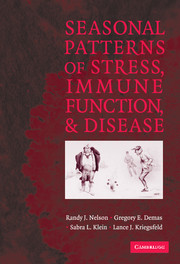Book contents
- Frontmatter
- Contents
- Acknowledgments
- Foreword
- Preface
- 1 Seasonality
- 2 Immune Function
- 3 Seasonal Fluctuations in Disease Prevalence
- 4 Seasonal Changes in Immune Function
- 5 Photoperiod, Melatonin, and Immunity
- 6 Energetics and Immune Function
- 7 Hormonal Influence on Immune Function
- 8 Clinical Significance of Seasonal Patterns of Immune Function and Disease
- References
- Index
Preface
Published online by Cambridge University Press: 11 November 2009
- Frontmatter
- Contents
- Acknowledgments
- Foreword
- Preface
- 1 Seasonality
- 2 Immune Function
- 3 Seasonal Fluctuations in Disease Prevalence
- 4 Seasonal Changes in Immune Function
- 5 Photoperiod, Melatonin, and Immunity
- 6 Energetics and Immune Function
- 7 Hormonal Influence on Immune Function
- 8 Clinical Significance of Seasonal Patterns of Immune Function and Disease
- References
- Index
Summary
Our environment changes seasonally. From the amount of light that we are exposed to each day to the availability of food and water, we are confronted with an ever-changing environment. As a consequence of these environmental changes, all inhabitants of Earth show fluctuations in energetically expensive physiological and behavioral processes throughout the year. Thus, adaptations have evolved so that energetically demanding processes coincide with abundant resources or other environmental conditions that promote survival and, ultimately, reproductive success. The study of seasonal changes in physiology and behavior in the field is typically limited to population dynamics among nondomesticated animals. Seasonal patterns of behaviors, including those associated with reproduction, social behavior, and daily activity, as well as seasonality in the physiology that underlies these behaviors, are well documented (Bronson and Heideman, 1994). Most studies of seasonality involve some aspect of seasonal breeding, such as mating, birth, or parental care. Seasonal patterns of illness and death are equally salient among natural populations of animals in the wild, but the underlying factors driving these seasonal patterns are much less studied than the extrinsic factors driving seasonal patterns of breeding. Generally, illness and death are most common during the fall and winter, compared with spring and summer, for most nontropical species.
One goal of our book is to describe an emerging hypothesis that individuals have evolved mechanisms to bolster immune function to counteract seasonally recurrent stressors that may otherwise compromise immune function. Seasonally recurrent stressors include food shortages, low ambient temperatures, and lack of cover from hungry predators. Survival thus represents maintaining the well-known energy budget and also maintaining a balance between stress-induced immunosuppression and endogenous rhythms of enhanced immune function.
- Type
- Chapter
- Information
- Seasonal Patterns of Stress, Immune Function, and Disease , pp. xiii - xviPublisher: Cambridge University PressPrint publication year: 2002
- 3
- Cited by

